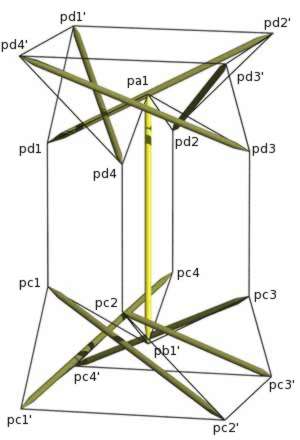
Aspension Canary with Point Labels
structure file: marcus/x4l3marcusx1.rc
variable file: marcus/x4l3marcusx1.dat
digit list: src/mm.dls
|
Member Descriptions
[name, end point names, weight (if in objective function),
second power of length (if a constraint), member category,
Obj/Con/Exc (put in objective function, use as a constraint or
exclude from computations), flags]
For assembly purposes, only the name and end point names are
of interest. The other information may be of interest after
A Practical Guide to Tensegrity Design has been consulted.
# struts
<Member> struta pb1' pa1 -1.0 sqr(0.612372435695794) 1 Con *
<Member> strutc1 pc2' pc1 -1.0 sqr(0.612372435695794) 1 Con *
<Member> strutc2 pc3' pc2 -1.0 sqr(0.612372435695794) 1 Con *
<Member> strutc3 pc4' pc3 -1.0 sqr(0.612372435695794) 1 Con *
<Member> strutc4 pc1' pc4 -1.0 sqr(0.612372435695794) 1 Con *
<Member> strutd1 pd2' pd1 -1.0 sqr(0.612372435695794) 1 Con *
<Member> strutd2 pd3' pd2 -1.0 sqr(0.612372435695794) 1 Con *
<Member> strutd3 pd4' pd3 -1.0 sqr(0.612372435695794) 1 Con *
<Member> strutd4 pd1' pd4 -1.0 sqr(0.612372435695794) 1 Con *
# interlayer tendons
<Member> xlta1 pd1 pc1 1.0 sqr(0.353553390593272) 3 Con *
<Member> xlta2 pd2 pc4 1.0 sqr(0.353553390593272) 3 Con *
<Member> xlta3 pd3 pc3 1.0 sqr(0.353553390593272) 3 Con *
<Member> xlta4 pd4 pc2 1.0 sqr(0.353553390593272) 3 Con *
<Member> xltb1 pb1' pc1 1.0 sqr(0.281508125152624) 3 Con *
<Member> xltb2 pb1' pc2 1.0 sqr(0.281508125152624) 3 Con *
<Member> xltb3 pb1' pc3 1.0 sqr(0.281508125152624) 3 Con *
<Member> xltb4 pb1' pc4 1.0 sqr(0.281508125152624) 3 Con *
<Member> xltc1 pc1' pc1 1.0 0.0 3 Obj *
<Member> xltc2 pc2' pc2 1.0 0.0 3 Obj *
<Member> xltc3 pc3' pc3 1.0 0.0 3 Obj *
<Member> xltc4 pc4' pc4 1.0 0.0 3 Obj *
<Member> xltd1 pd1' pd1 1.0 0.0 3 Obj *
<Member> xltd2 pd2' pd2 1.0 0.0 3 Obj *
<Member> xltd3 pd3' pd3 1.0 0.0 3 Obj *
<Member> xltd4 pd4' pd4 1.0 0.0 3 Obj *
<Member> xlte1 pa1 pd1 1.0 sqr(0.281508125152624) 3 Con *
<Member> xlte2 pa1 pd2 1.0 sqr(0.281508125152624) 3 Con *
<Member> xlte3 pa1 pd3 1.0 sqr(0.281508125152624) 3 Con *
<Member> xlte4 pa1 pd4 1.0 sqr(0.281508125152624) 3 Con *
# end tendons
<Member> endc1' pc2' pc1' 1.0 sqr(0.50) 4 Con *
<Member> endc2' pc3' pc2' 1.0 sqr(0.50) 4 Con *
<Member> endc3' pc4' pc3' 1.0 sqr(0.50) 4 Con *
<Member> endc4' pc1' pc4' 1.0 sqr(0.50) 4 Con *
<Member> endd1' pd2' pd1' 1.0 sqr(0.50) 4 Con *
<Member> endd2' pd3' pd2' 1.0 sqr(0.50) 4 Con *
<Member> endd3' pd4' pd3' 1.0 sqr(0.50) 4 Con *
<Member> endd4' pd1' pd4' 1.0 sqr(0.50) 4 Con *
In-Situ Member Lengths
These are the lengths of the members when they are in place
and prestress is applied. The strut lengths are from pin insertion
point to pin insertion point, as are the tendon lengths.
The values are in model units.
struta: 0.612372 strutc1: 0.612372 strutc2: 0.612372
strutc3: 0.612372 strutc4: 0.612372 strutd1: 0.612372
strutd2: 0.612372 strutd3: 0.612372 strutd4: 0.612372
xlta1: 0.353553 xlta2: 0.353553 xlta3: 0.353553
xlta4: 0.353553 xltb1: 0.281508 xltb2: 0.281508
xltb3: 0.281508 xltb4: 0.281508 xltc1: 0.353553
xltc2: 0.353553 xltc3: 0.353553 xltc4: 0.353553
xltd1: 0.353553 xltd2: 0.353553 xltd3: 0.353553
xltd4: 0.353553 xlte1: 0.281508 xlte2: 0.281508
xlte3: 0.281508 xlte4: 0.281508 endc1': 0.5
endc2': 0.5 endc3': 0.5 endc4': 0.5
endd1': 0.5 endd2': 0.5 endd3': 0.5
endd4': 0.5
Relative Member Force Magnitudes
These values are useful for developing an assembly
strategy for the structure. The tighter tendons are much
easier to tie in place early on, while the looser tendons
can be left to the last. This information is also used
to adjust tendon lengths since the measured length of a tendon
will be shorter for a highly-stressed tendon with the same
in-situ length as a tendon which is not so stressed.
struta: -1.03528 strutc1: -0.612372 strutc2: -0.612372
strutc3: -0.612372 strutc4: -0.612372 strutd1: -0.612372
strutd2: -0.612372 strutd3: -0.612372 strutd4: -0.612372
xlta1: 0.258819 xlta2: 0.258819 xlta3: 0.258819
xlta4: 0.258819 xltb1: 0.563016 xltb2: 0.563016
xltb3: 0.563016 xltb4: 0.563016 xltc1: 0.353553
xltc2: 0.353553 xltc3: 0.353553 xltc4: 0.353553
xltd1: 0.353553 xltd2: 0.353553 xltd3: 0.353553
xltd4: 0.353553 xlte1: 0.563016 xlte2: 0.563016
xlte3: 0.563016 xlte4: 0.563016 endc1': 0.25
endc2': 0.25 endc3': 0.25 endc4': 0.25
endd1': 0.25 endd2': 0.25 endd3': 0.25
endd4': 0.25
Average tendon force magnitude: 0.37028
Construction Lengths (in millimeters and halves)
The construction length of a tendon is less than the in-situ
length since when the tendon is measured off it isn't under
any prestress force. The construction length for the strut
represents the length of the 3/16-inch-diameter wooden dowel.
The tendons were made of 15-lb.-test braided nylon fishing line.
In this case, the attachment point at the hubs was a simple
metal pin stuck into the end of the strut, so no member-length
adjustments were necessary. Prestress forces are assumed
not to affect strut lengths.
Elongation of Tendon of Unit Cross Section
Under Force of Average Magnitude (fraction)> .02
Length Scale Factor> 100/0.612372435695794
Strut and Tendon Hub Adjustments - s;t> 0 0
struta: 100 0 strutc1: 100 0 strutc2: 100 0 strutc3: 100 0
strutc4: 100 0 strutd1: 100 0 strutd2: 100 0 strutd3: 100 0
strutd4: 100 0 xlta1: 57 0 xlta2: 57 0 xlta3: 57 0
xlta4: 57 0 xltb1: 44 1 xltb2: 44 1 xltb3: 44 1
xltb4: 44 1 xltc1: 56 1 xltc2: 56 1 xltc3: 56 1
xltc4: 56 1 xltd1: 56 1 xltd2: 56 1 xltd3: 56 1
xltd4: 56 1 xlte1: 44 1 xlte2: 44 1 xlte3: 44 1
xlte4: 44 1 endc1': 80 1 endc2': 80 1 endc3': 80 1
endc4': 80 1 endd1': 80 1 endd2': 80 1 endd3': 80 1
endd4': 80 1

Aspension Canary with Point Labels
structure file: marcus/x4l3marcusx1.rc
variable file: marcus/x4l3marcusx1.dat
digit list: src/mm.dls
|
|
CONTACT: Bob Burkhardt Tensegrity Solutions Box 426164 Cambridge, MA 02142-0021 USA e-mail: bobwb@juno.com |